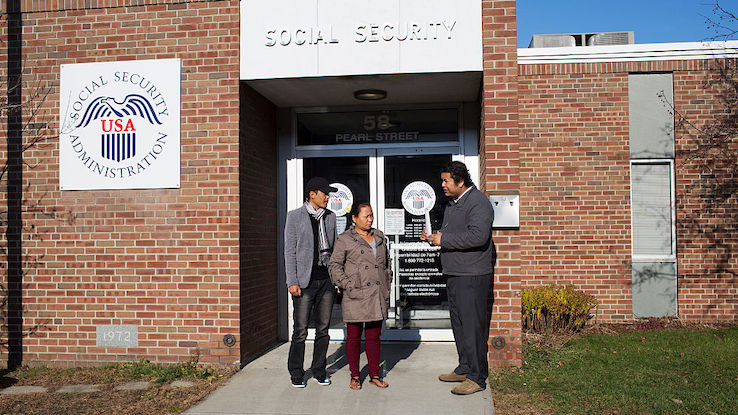
If you’re thinking about retiring soon or are nearing your 60th birthday, you’re probably also starting to wonder more about Social Security benefits. There’s a lot to learn and some of the rules can get complex, which can make understanding how and when to get benefits — and what they include — somewhat of a challenge. Before you begin the process of applying for Social Security, get started by reviewing some of the basics about the program to answer some common questions you might have.
The Background and Purpose of Social Security
First things first: What is Social Security? Originally signed into law by President Franklin D. Roosevelt in 1935, what we call Social Security actually refers to what’s officially known as Old Age, Survivors and Disability Insurance. It’s funded by payroll taxes — money paid out by employees via paycheck deductions and by employers — and is a form of social insurance administered by the U.S. federal government. This means that it’s a program that involves the government participating in the insurance market to provide extra assistance to certain groups and protect them against financial issues that arise after emergencies.

Perhaps the best-known and largest component of Social Security is the retirement benefits it pays out. In that case, these payments are intended to keep people who worked lower-wage jobs throughout their lives from living in relative poverty when they leave the workforce as they age. However, the Social Security Administration (SSA) also makes payments to people with disabilities who cannot work and to survivors of workers who’ve died. According to the SSA, the purposes of these payments are “to provide for the material needs of individuals and families, “to protect aged and disabled persons against the expenses of illnesses that may otherwise use up their savings” and “to keep families together.”
It’s important to note that Social Security benefits are intended to be supplemental — that is, they’re not supposed to serve as someone’s sole source of income when they retire. The benefit payments are meant to provide a boost to other retirement income, such as a pension.
Social Security Eligibility: The Credit System
Depending on your life circumstances, you could be eligible to receive Social Security benefits at any age — not just the traditional retirement age of 62. For example, to receive disability benefits, you may be eligible at almost any age as long as you’ve worked long enough and recently enough and have a qualifying medical condition that limits your ability to work. You may also be able to receive survivors benefits in some circumstances if you’re a surviving family member of a deceased person who “worked long enough in jobs insured under Social Security to qualify for benefits.”

Disability and survivors benefit payments have relatively straightforward eligibility requirements to meet. Social Security retirement benefits do as well, but the ways eligibility and amounts are determined and the details involved can look somewhat complicated at first glance. Understanding eligibility for Social Security benefits involves learning about credits first.
Your eligibility for receiving Social Security is based in part on credits that you earn while working. When you’re employed and Social Security taxes are deducted from your paycheck for receipt by the Internal Revenue Service (IRS) you start earning credits. These credits are based on the amount of money you earn each year, and you can earn up to four credits per year. For example, in 2020, earning $1,410 in wages at your job earns you one credit. Using this number as another example, once you’ve earned $5,640 ($1,410 x 4) in wages from your job, you’ve earned your four credits for the year and cannot earn more credits until the next year. The base amount of money you need to earn from your job to earn one credit increases slightly each year to account for inflation.
To qualify to receive Social Security retirement benefits, you must earn at least 40 credits, which equates to 10 years’ worth of work. You don’t need to work 10 consecutive years to earn the credits, however. Any credits you receive remain on your Social Security record, and if you leave a job and return to the workforce years later, you can begin accumulating credits again until you reach 40 and become eligible for benefits payments.
The number of credits needed to determine your eligibility for disability or survivors benefits depends on your age; generally speaking, the younger you are, the fewer the number of credits is that you need to become eligible. The age table on the Social Security Administration’s website can give you a better idea of the number of credits relative to your age that you’ll need to have earned to determine eligibility for disability or survivors benefits.
What Role Does Your Age Play?
As mentioned, age can be a determining factor in the number of credits you’ll need for eligibility for two types of payments. However, when it comes to retirement benefits, your age can also play a role in not only when you’re eligible to start receiving payments but also in the amounts of those payments. In particular, you’ll want to think about the age at which you decide to start claiming your Social Security retirement payments.

The age when you start claiming determines whether you receive 100% of your Social Security benefits. If you’re eligible to receive Social Security retirement benefits, you can start getting them as early as age 62. However, your payment amounts will be less than they are if you wait until what’s called your “full retirement age.” This is the age at which you’re eligible to receive 100% of your benefit amount every month, and it’s typically between ages 66 and 67, depending on the year you were born. So, drawing earlier than your full retirement age results in you receiving a reduced amount in benefits — the Social Security Administration notes that you’ll get about 28% less than you would if you wait until age 66.
Waiting until you’re older than full retirement age to quit working and draw benefits can also impact the amount you receive every month. Because you’re working longer, you’ll receive a larger monthly amount than if you retired at 66. For each month you delay claiming benefits, the amount you can receive monthly increases slightly, and if you wait until age 70, you’ll get 132% of your Social Security benefit amount. Once you turn 70 and haven’t started claiming yet, your benefit amount won’t keep increasing, so that 132% is the most you can get each month if you delay claiming to continue working.





